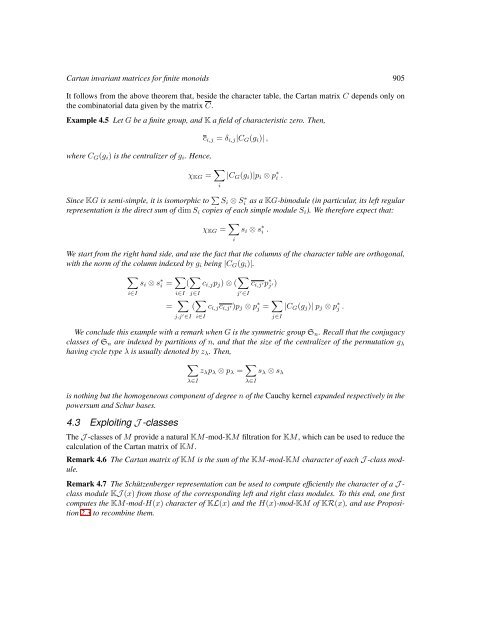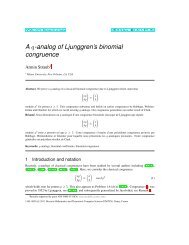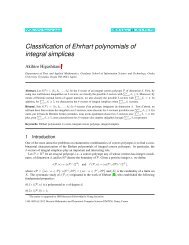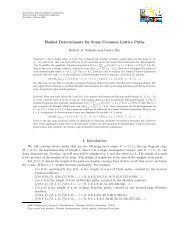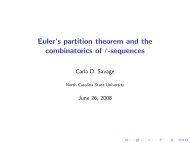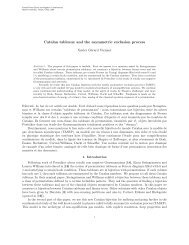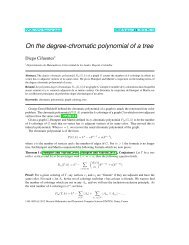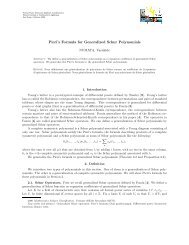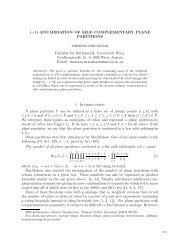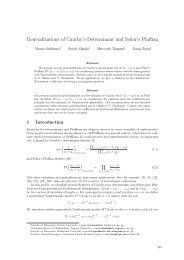Cartan invariant matrices for finite monoids - Nagoya University
Cartan invariant matrices for finite monoids - Nagoya University
Cartan invariant matrices for finite monoids - Nagoya University
You also want an ePaper? Increase the reach of your titles
YUMPU automatically turns print PDFs into web optimized ePapers that Google loves.
<strong>Cartan</strong> <strong>invariant</strong> <strong>matrices</strong> <strong>for</strong> <strong>finite</strong> <strong>monoids</strong> 905<br />
It follows from the above theorem that, beside the character table, the <strong>Cartan</strong> matrix C depends only on<br />
the combinatorial data given by the matrix C.<br />
Example 4.5 Let G be a <strong>finite</strong> group, and K a field of characteristic zero. Then,<br />
where C G (g i ) is the centralizer of g i . Hence,<br />
c i,j = δ i,j |C G (g i )| ,<br />
χ KG = ∑ i<br />
|C G (g i )|p i ⊗ p ∗ i .<br />
Since KG is semi-simple, it is isomorphic to ∑ S i ⊗ Si ∗ as a KG-bimodule (in particular, its left regular<br />
representation is the direct sum of dim S i copies of each simple module S i ). We there<strong>for</strong>e expect that:<br />
χ KG = ∑ i<br />
s i ⊗ s ∗ i .<br />
We start from the right hand side, and use the fact that the columns of the character table are orthogonal,<br />
with the norm of the column indexed by g i being |C G (g i )|.<br />
∑<br />
s i ⊗ s ∗ i = ∑ ( ∑ c i,j p j ) ⊗ ( ∑ c i,j ′p ∗ j ′)<br />
i∈I<br />
i∈I j∈I<br />
j ′ ∈I<br />
= ∑<br />
c i,j c i,j ′)p j ⊗ p ∗ j = ∑ |C G (g j )| p j ⊗ p ∗ j .<br />
j∈I<br />
j,j ′ ∈I( ∑ i∈I<br />
We conclude this example with a remark when G is the symmetric group S n . Recall that the conjugacy<br />
classes of S n are indexed by partitions of n, and that the size of the centralizer of the permutation g λ<br />
having cycle type λ is usually denoted by z λ . Then,<br />
∑<br />
s λ ⊗ s λ<br />
λ∈I<br />
z λ p λ ⊗ p λ = ∑ λ∈I<br />
is nothing but the homogeneous component of degree n of the Cauchy kernel expanded respectively in the<br />
powersum and Schur bases.<br />
4.3 Exploiting J -classes<br />
The J -classes of M provide a natural KM-mod-KM filtration <strong>for</strong> KM, which can be used to reduce the<br />
calculation of the <strong>Cartan</strong> matrix of KM.<br />
Remark 4.6 The <strong>Cartan</strong> matrix of KM is the sum of the KM-mod-KM character of each J -class module.<br />
Remark 4.7 The Schützenberger representation can be used to compute efficiently the character of a J -<br />
class module KJ (x) from those of the corresponding left and right class modules. To this end, one first<br />
computes the KM-mod-H(x) character of KL(x) and the H(x)-mod-KM of KR(x), and use Proposition<br />
2.3 to recombine them.


